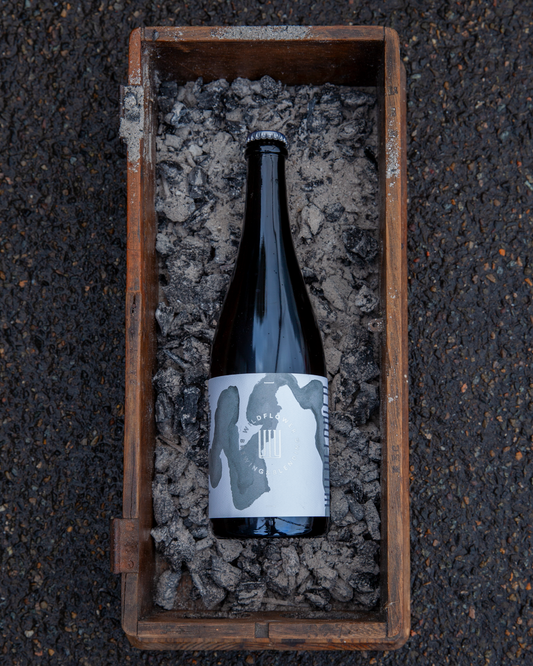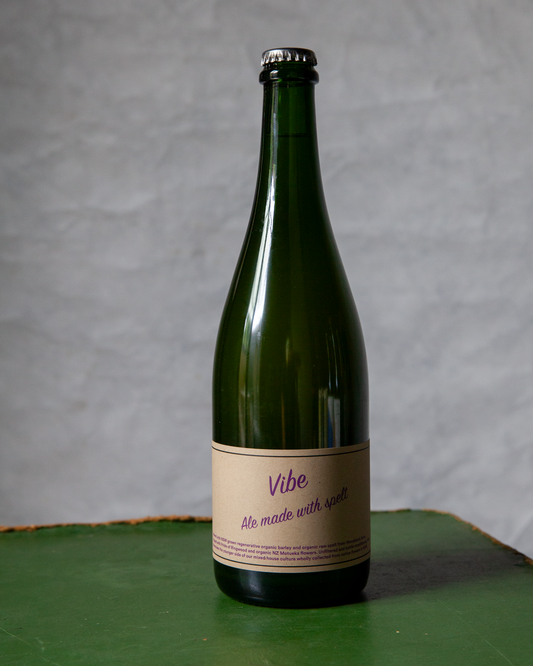It has been a week since I posted this photo in a moment of loss. I probably didn’t need to share in live time the pain and fear I felt on Instagram but it may say something about the almost obligation I feel to be honest with those of you that follow our process.
But what happened… Chase and I had just finished a double brew day of two, small 500 l batches of beer and were preparing to pitch our house yeast culture into them, both from liquid form as collected from a previous batch as well as from some actively fermenting beer, which we do from time to time to really get things going. Before we inoculated though, Chase raised a red flag on the flavour of the young (1.5wk), fermenting batch of Gold that we were planning to use. I smelled it, tasted it and had a physical reaction to the drink that made me immediately spit it out. The young beer shared no similarity to anything we had ever fermented in the nearly 5 years of brewing with this culture. The beer had a super sulphur-y nose, I’d say 5-10x stronger than something I would consider ‘normal’, a foreign fruitiness that I can’t quite describe but it wasn’t pleasant and a sharp back palate with an acetic bite. My gut sank immediately. So by then I knew the ~2,600 litres of Gold in tank was no good, next step was to taste the beer we brewed previously to that one, the one who’s yeast we pitched into that batch of Gold. It was Organic Table beer, again ~2,600 litres, same issue. We had transferred it 12 days before and not seen this issue, so I have to believe there was something going on under our noses about ready to bloom.
At this stage I have already written off about 5,200 litres of beer in my head, about 10% of our annual production… its a blow but one I can recover from. The real straw that did it was when I tasted the liquid yeast itself from our brink (the vessel that contains the collected culture from a previous fermentation which is then pitched into a subsequent one). Even this culture bore a resemblance to the issues we saw in both these ferments and I knew that by putting this culture into an unfermented wort, I would essentially be submitting that wort to the same fate the batches of Gold and Organic Table beer had seen.
Now is probably a good time to mention that we do not keep a ‘backup’ of our house culture, doing that is essentially impossible. The culture is not stoic, it evolves and mutates through every generation, it’s not a set composition of x% of this and y% of that. Any attempt to ‘bank’ the culture or ‘save’ it (as you would a document on your computer) merely takes a snapshot of the culture at that moment. But if we were to continue to use the normal culture (not the backup), it would keep moving, keep drifting and then there raises a question about which one is the house culture. I’d say the one in the beer, not the one isolated and frozen in some lab.
I’ve always thought and said that something like this could happen, ‘we could lose the culture’ and I’ve always thought and said that we would be able to rebuild it from the barrels and beers that we have on hand…. these things I thought and said… if I’m being honest I’d hoped I’d never have to do.
So here we are at 6pm on a Friday night with this issue, right when we wanted to get going home. We had to do something. I knew I wouldn’t be able to sleep otherwise.
The good part, I guess, of this situation is that we had fresh wort on hand right then and there. So Chase and I made a plan to split this wort three ways into three separate ferments, split up our eggs, inoculate each of these with different cultures and see if we could right then resurrect the culture from older batches of our own beer.
At the same time I made the decision to get rid of both the offending batches of Gold (109/110) and Organic Table Beer (26/27), about ~5,200 l of beer. A portion of this was set aside in a separate vessel to be given to a local distillery and a portion was sent down the drain. This is an action I do not take lightly. In fact I hate it. To mark it useless smacks in the face of the producers and environment that grew the barley and hops, gave the water and frankly made that beer in the first place. It goes directly against my general and more usual approach to minimise or eliminate waste. It is instead an entirely wasteful decision… and I hate that about this decision. The reason I made it was an issue of timing, we had wort that needed culture as soon as possible to save it and we had culture that needed wort as soon as possible to save it. I had to clean out the problematic ferments in order to make space for the ones that might be able to rectify the situation. Its not ideal, I know.
So a bunch of beer was dumped, I dumped the liquid house culture in the brink (this is the really its over moment) and Chase and I cleaned and cleaned the tanks to at least take that out of the equation as to what was going on. We split the wort three ways
- about 400 litres of a wort brewed with gentian and wormwood had already received the problematic liquid yeast from the brink before we realised it was an issue… so it was left alone to ferment with that culture. In hindsight, this could be a stroke of luck to have brewed that wort and inoculated it with that culture. Wormwood in particular has antibacterial properties so we could have a successful ferment from it. Its too soon to tell.
- About 200 l of a ~10P wort lightly hopped with aged hops was blended with a roughly equal portion of the youngest batch of our beer that we felt didn’t share the off flavour. Keeping direct track of the generations of our culture can be hard because we blend sometimes and do other non-linear things to coax it one way or another but it looks like it was around generation 114 where things went wrong with the batch of OTB, so gen 113 fermented Gold Batch 107/108 which started ferment on 9 June 2021…. so its just over 5 weeks old at this point. Its dry, but likely still enough active yeast to ferment work.
- And a second 200 l of the same wort as (2) was inoculated with beer from the generation of yeast before that one, gen 112… which was used to ferment Gold Batch 106, started 24 May… nearly 8 weeks old… it could be a stretch but its worth a shot.
Late on Friday night we split these up, tucked them into the warm room to start their fermentations and crossed our fingers.
So where to from here… well in an odd way this event has also given us an opportunity in some ways to slow brewing, take stock and decide what the best way forward is. As it is winter time in the Southern Hemisphere right now, there is a huge variety of native trees flowering, queen amongst them, for us, is the golden wattle. Each year we make a 100% wattle ferment beer called Wattle Drops and know it is quite possible to borrow a really lovely culture from its blossoms.
So unknowingly to ourselves which is the back-up culture and which isn’t, we are going to conduct another round of wild captures from native flora here in NSW this winter, just like in 2016 when I built the culture. This will be happening at the same time as we attempt to resurrect the house culture and somewhere down the line we’ll make a choice about which one to proceed with. On both of these fronts, the wild captures as well as the end decision, I’ll continue documenting and sharing the results.
As for what this means for our releases… actually very little. There will be a pause in Organic Table Beer and Good as Gold releases in probably 4-6 months time. But until then, there won’t be a difference at all. Recalling that all of our beer spends a considerable amount of time in bottle before release, we have most of everything for 2021 either in bottle or well finished brewed preparing for bottling. So fear not, the way we make beer has these kind of contingencies built-in.
Lastly, when this post goes on Instagram, I’ll be disabling comments. If you are an experienced mixed culture brewer and have some helpful anecdotes to share, please get in contact with me, it’s very easy. However, I don’t share this to attract opinions on troubleshooting what happened. By no means do I believe that my experience is wider or knowledge deeper than any practitioner of fermentations and that these external thoughts are not valid. No, merely that I have confidence in myself, our small team and the handful of friends that I call on for help at these times to figure it out and move on. Also, in all honesty, I’m probably not strong enough to deal with any accusations that my cleaning regime, yeast handling or something process-wise was what caused this… I couldn’t take that. So there.
At the start of last month, we celebrated our fourth birthday as operating beer makers. We have learned many things in these short years and have been incredibly lucky to share our beers with so many people around the world. With that has come some recognition that our beer is ‘good’ or that our beer merits some rank in the world of mixed culture beer. In just four short years our beers or views on ingredients have been cited as inspirations for others. I can’t tell you how humbling that is, but what is harder to explain is how nerve racking that can be, to be ranked or held up in someone else’s eyes. It makes you feel like you can’t slip up… every.single.dish. must be perfect. I have always been honest and open about the beer here, but it makes me vulnerable as well. So I’m sorry if this changes your view on our beer, our brewery or me directly. We will learn from this and get better.
-topher




